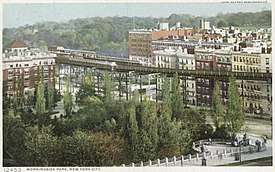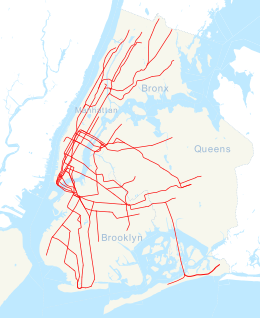110th Street station (IRT Ninth Avenue Line)
110th Street was a local station on the demolished IRT Ninth Avenue Line. It had two levels. The lower level was built first and had two tracks and two side platforms and served local trains. The upper level was built as part of the Dual Contracts and had one track that served express trains that bypassed this station. It opened on June 3, 1903 and closed on June 11, 1940. The next southbound stop was 104th Street. The next northbound stop was 116th Street. This station was one of the few to have elevators as it was the highest station in the entire system, also this height reportedly made this station very popular for suicide jumps. The common suicides, combined with the line's 90° turns from Ninth Avenue (now Columbus Avenue) onto Eighth avenue (now Frederick Douglass Boulevard), subsequently earned the station, and the area of track around it, the nickname Suicide Curve.[2]
110th Street | |||||||||||||||||||||||||||||
|---|---|---|---|---|---|---|---|---|---|---|---|---|---|---|---|---|---|---|---|---|---|---|---|---|---|---|---|---|---|
| Former New York City Subway station | |||||||||||||||||||||||||||||
 110th Street Station's suicide curve looking south from Morningside Park with the station platforms and the elevator tower’s peaked roof visible on the left. | |||||||||||||||||||||||||||||
| Station statistics | |||||||||||||||||||||||||||||
| Address | West 110th Street and Manhattan Avenue New York, NY 10025 | ||||||||||||||||||||||||||||
| Borough | Manhattan | ||||||||||||||||||||||||||||
| Locale | Upper West Side, Morningside Heights | ||||||||||||||||||||||||||||
| Coordinates | 40°48′4.02″N 73°57′34.7″W | ||||||||||||||||||||||||||||
| Division | A (IRT) | ||||||||||||||||||||||||||||
| Line | IRT Ninth Avenue Line | ||||||||||||||||||||||||||||
| Services | None | ||||||||||||||||||||||||||||
| Platforms | 2 side platforms | ||||||||||||||||||||||||||||
| Tracks | 3 (1 upper level) (2 lower level) | ||||||||||||||||||||||||||||
| Other information | |||||||||||||||||||||||||||||
| Opened | June 3, 1903 | ||||||||||||||||||||||||||||
| Closed | June 11, 1940[1] | ||||||||||||||||||||||||||||
| Station succession | |||||||||||||||||||||||||||||
| Next north | 116th Street | ||||||||||||||||||||||||||||
| Next south | 104th Street | ||||||||||||||||||||||||||||
| |||||||||||||||||||||||||||||
| |||||||||||||||||||||||||||||
| |||||||||||||||||||||||||||||
According to Douglas (2004), the station was a popular site for suicide jumpers. In 1927, The New York Times reported that:
The number of suicides from the 110th Street Station of the Sixth Avenue elevated is ruining the business of the merchants with shops below, according to [the merchants].... According to [a spokesperson] there were eleven suicides from that station in the past year, and the effect has been such that potential customers prefer to walk a little farther rather than risk seeing a person hurtle from above.[3][4]
References
- "Tonight to See City Pass Goal of Unification". New York Daily News. June 10, 1940. p. 37. Retrieved June 30, 2019 – via Newspapers.com.

- "Ninth Avenue Local". Station Reporter. Archived from the original on 2011-07-24. Retrieved 2009-01-25.
- Douglas, George H. (2004): Skyscrapers: A Social History of the Very Tall Building in America. McFarland & Company, ISBN 0-7864-2030-8. (110th St station popular for suicides: p. 170).
-
- "Merchants Complain Suicides Hurt Business; Seek Way to Guard 110th St. Elevated Station" - New York Times, January 31, 1927, p. 19
External links
.jpg)



%26groups%3D_43e1c6130657e66ccc3b6365d08d4234dfaec6af.svg)